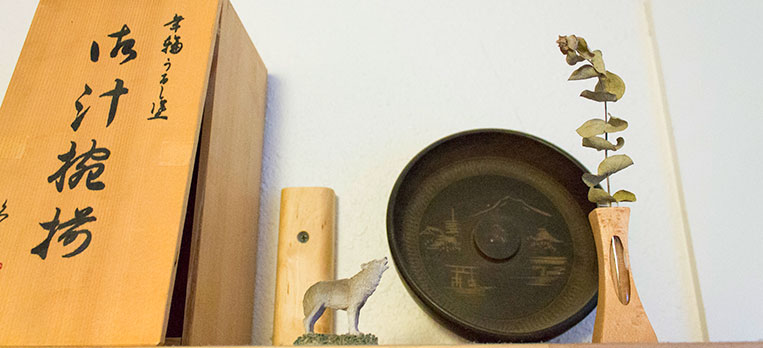
By Billy Ulmer, author of the Life in a Tiny House Ebook.
Last week I signed up for the “Unshopping Challenge,” a commitment to buy nothing new for a month, except consumables like food and gas. I wanted to take the challenge because I’ve been thinking about my possessions more than usual lately. It’s spring cleaning time, and I have the urge to purge. But it’s also my birthday soon, so I have the urge to treat myself, too. When I’m already having strong, mixed feelings about my relationship to material life, what better time to learn from it?
I purposely took on the challenge at a time when I knew I might fail. In fact, I might have already lost the challenge, depending on how you interpret it. But for me, the point isn’t to win for a month, it’s to spend a month examining why I do what I do, and apply that knowledge to the rest of the year. So win, lose or draw, I’ll be documenting what I learn in three posts: beginning, middle and end. And I’ll start with some of the first steps I took earlier in my life to change my relationship to stuff: figuring out why I loved to buy, and forgiving myself for buying the wrong things.
Where Stuff Comes From
People’s relationships to possessions probably vary even more than their relationships to homes, so it helps to establish some context for mine. In recent years I’ve become a pretty conscious consumer, mostly because I am cheap. And while I have always been cheap, I used to rely much more heavily on toys, clothes and other stuff to improve my life. My thrift was not a product of financial or environmental responsibility, but of a money-hoarder mentality. I would save money obsessively, consider all the different things I might buy with it and which would make me happiest, and then spend it all on something that could never live up to my sky-high expectations. The happiness of stuff, for me, came about 90% from the anticipation, so over time I accumulated a lot of possessions, and a slowly-mounting sense of guilt about it.
When I got out of college, I was surrounded by stuff I had essentially forgotten about for four years. So clearly I didn’t “need” it, but the idea of giving it away bummed me out. It meant admitting I’d done something wrong. I began devouring books from the library about “voluntary simplicity” to hear repeated stories about the joy and freedom people felt when they got rid of stuff. Which was confusing, because I thought joy and freedom were what I felt when I acquired them. And that was what I felt at the time! But that’s the thing about feelings – they can become associated with anything.

What Shopping (And Unshopping) Feels Like
I owned shelves and shelves of books that I happily acquired. I would hear about an interesting book, and then enjoy the entire process of getting ahold of it: driving out from my little town to a decent bookstore, shopping around while I was there, and finally taking it home. Ordering things through the mail was differently fun – it could arrive any day now! At the time, it was rare for me to actually end up reading these books. They were all too dry or dense or over my head. But the process of buying them felt productive (“I’m going to learn!”) and became a pleasant ritual – seeking, finding, acquiring.
I liked the anticipation, process and promise of the books more than the books themselves. When I figured this out, I resolved to spend my money more wisely, and off-load the dozens of books I’d bought to assemble a library of knowledge I thought I wanted. But actually getting rid of them felt…weird. It was admitting two big emotional hits – I’d been a bad, thoughtless consumer, and even worse, wasted my own money. But underneath the regret, there was a new potential – feeling free of the reminders of those mistakes, and newly joyful about shedding the unnecessary stuff that surrounded me. Like a snake shedding its skin, it would be a little awkward, but totally worth it.
Swapping Behaviors For the Same Feeling
The Unshopping Challenge was created by Yerdle, an app that helps people swap the perfectly nice stuff they have and don’t want anymore for the perfectly nice stuff someone else has and doesn’t want anymore. The app takes a smart stance on its mission to “reduce the number of new things we all have to buy by 25%,” because it doesn’t try to scold people to change their behavior. If you’re trying to encourage people to change what and how they buy, you’ve got to get to why they do it. For a lot of people, shopping feels good. Shopping feels like a reward – you’ve earned it. You can’t just take that away from people, you’ve got to replace it with something else that feels just as good. In Yerdle’s case, it’s “unshopping” for other people’s stuff. But you can also work toward that same mission by swapping clothes with friends, visiting thrift stores, scouring Craigslist, and so on.

It was relatively easy for me to start parting with books first because I could get some of my money back. This softened the blow of one of those two emotional hits I took when I started regretting the purchases – that I’d wasted my money. I wheeled an intensely heavy suitcase into the city to sell back as many books as I could. I made what felt like a small fortune, looked at the dusty spots on my shelves, and felt doubly good. “I made money by getting rid of something I wasn’t even using! I lost a burden, and gained an opportunity!“ The attitude that makes unshopping fun is that letting go of something is a gain, not a loss – whether it’s literal dollars in your pocket, newly-accessible shelf space, or getting free of the reminder of the mistake you made.
Moving Forward
I had to figure out why buying a library full of books felt good in the first place before I could start doing anything differently, because that was what helped me forgive myself and move on, and understand what I was really trying to accomplish, and do something more productive to accomplish it instead. I’m now happily addicted to the library and the book sections of thrift stores, which works better for me in literally every way.
If you want to make a change about what you already own, I recommend the following internal monologue: “No, I don’t have to beat myself up about how I don’t want this stuff anymore. And yes, getting rid of it can feel as good as getting it in the first place.”
* * * * *
Check out my Life in a Tiny House Ebook for more inspiring stories of people building lives around what matters most to them.

Comments are closed.